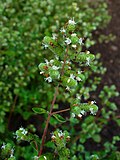Note: This is a project under development. The articles on this wiki are just being initiated and broadly incomplete. You can Help creating new pages.
Origanum majorana - Ajanmasurabhi, Majorana
Origanum majorana is a perennial plant that can grow up to 0.60 metres tall. It is harvested from the wild for local use as a food, medicine and source of materials.
Contents
[hide]- 1 Uses
- 2 Parts Used
- 3 Chemical Composition
- 4 Common names
- 5 Properties
- 6 Habit
- 7 Identification
- 8 List of Ayurvedic medicine in which the herb is used
- 9 Where to get the saplings
- 10 Mode of Propagation
- 11 How to plant/cultivate
- 12 Commonly seen growing in areas
- 13 Photo Gallery
- 14 References
- 15 External Links
Uses
Indigestion, Painful menstrual cramps, Stomach cramps, Liver problems, Gallstones, Menopause symptoms, Nerve pain, Earache.[1]
Parts Used
Chemical Composition
It contains origanol and origanol along with ursolic acid, oleanolic acid, β-sitosterol, and triacontanol.[3]
Common names
| Language | Common name |
|---|---|
| Kannada | Marubaka |
| Hindi | Marva |
| Malayalam | |
| Tamil | Marru |
| Telugu | Maruvamu |
| Marathi | |
| Gujarathi | |
| Punjabi | |
| Kashmiri | |
| Sanskrit | Marubaka |
| English | Sweet Marjoram |
Properties
Reference: Dravya - Substance, Rasa - Taste, Guna - Qualities, Veerya - Potency, Vipaka - Post-digesion effect, Karma - Pharmacological activity, Prabhava - Therepeutics.
Dravya
Rasa
Guna
Veerya
Vipaka
Karma
Prabhava
Habit
Identification
Leaf
| Kind | Shape | Feature |
|---|---|---|
Flower
| Type | Size | Color and composition | Stamen | More information |
|---|---|---|---|---|
| Flowering season is February - May |
Fruit
| Type | Size | Mass | Appearance | Seeds | More information |
|---|---|---|---|---|---|
| Fruiting season is February - May |
Other features
List of Ayurvedic medicine in which the herb is used
Where to get the saplings
Mode of Propagation
How to plant/cultivate
Considered a tender perennial (USDA Zones 7–9),[7] marjoram can sometimes prove hardy even in zone 5.[5]
Commonly seen growing in areas
Meadows, Fields, Anthropogenic, Dry slopes and rocky places, Occasionally in partial shade.[6]
Photo Gallery
References
- Jump up ↑ Karnataka Medicinal Plants Volume - 2 by Dr.M. R. Gurudeva, Page No. 554
- ↑ Jump up to: 2.0 2.1 "Karnataka Medicinal Plants Volume - 2" by Dr.M. R. Gurudeva, Page No.553, Published by Divyachandra Prakashana, #45, Paapannana Tota, 1st Main road, Basaveshwara Nagara, Bengaluru.
- Jump up ↑ Chemical constituents
- Jump up ↑ [Morphology]
- Jump up ↑ Cultivation
- Jump up ↑ Commonly seen growing in areas
External Links
- Ayurvedic Herbs known to be helpful to treat Indigestion
- Ayurvedic Herbs known to be helpful to treat Painful menstrual cramps
- Ayurvedic Herbs known to be helpful to treat Stomach cramps
- Ayurvedic Herbs known to be helpful to treat Liver problems
- Ayurvedic Herbs known to be helpful to treat Gallstones
- Ayurvedic Herbs known to be helpful to treat Menopause symptoms
- Ayurvedic Herbs known to be helpful to treat Nerve pain
- Ayurvedic Herbs known to be helpful to treat Earache
- Herbs with Leaves used in medicine
- Herbs with Root used in medicine
- Herbs with common name in Kannada
- Herbs with common name in Hindi
- Herbs with common name in Tamil
- Herbs with common name in Telugu
- Herbs with common name in Sanskrit
- Herbs with common name in English
- Habit - Perennial
- Index of Plants which can be propagated by Seeds
- Index of Plants which can be propagated by Cuttings
- Herbs that are commonly seen in the region of Meadows
- Herbs that are commonly seen in the region of Fields
- Herbs that are commonly seen in the region of Anthropogenic
- Herbs that are commonly seen in the region of Dry slopes and rocky places
- Herbs that are commonly seen in the region of Occasionally in partial shade
- Herbs
- Ayurvedic herbs that don't have seed photos
- Lamiaceae



